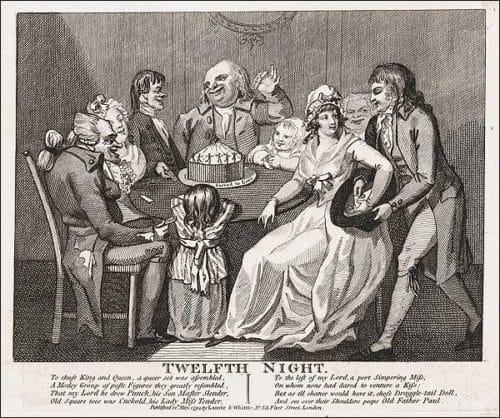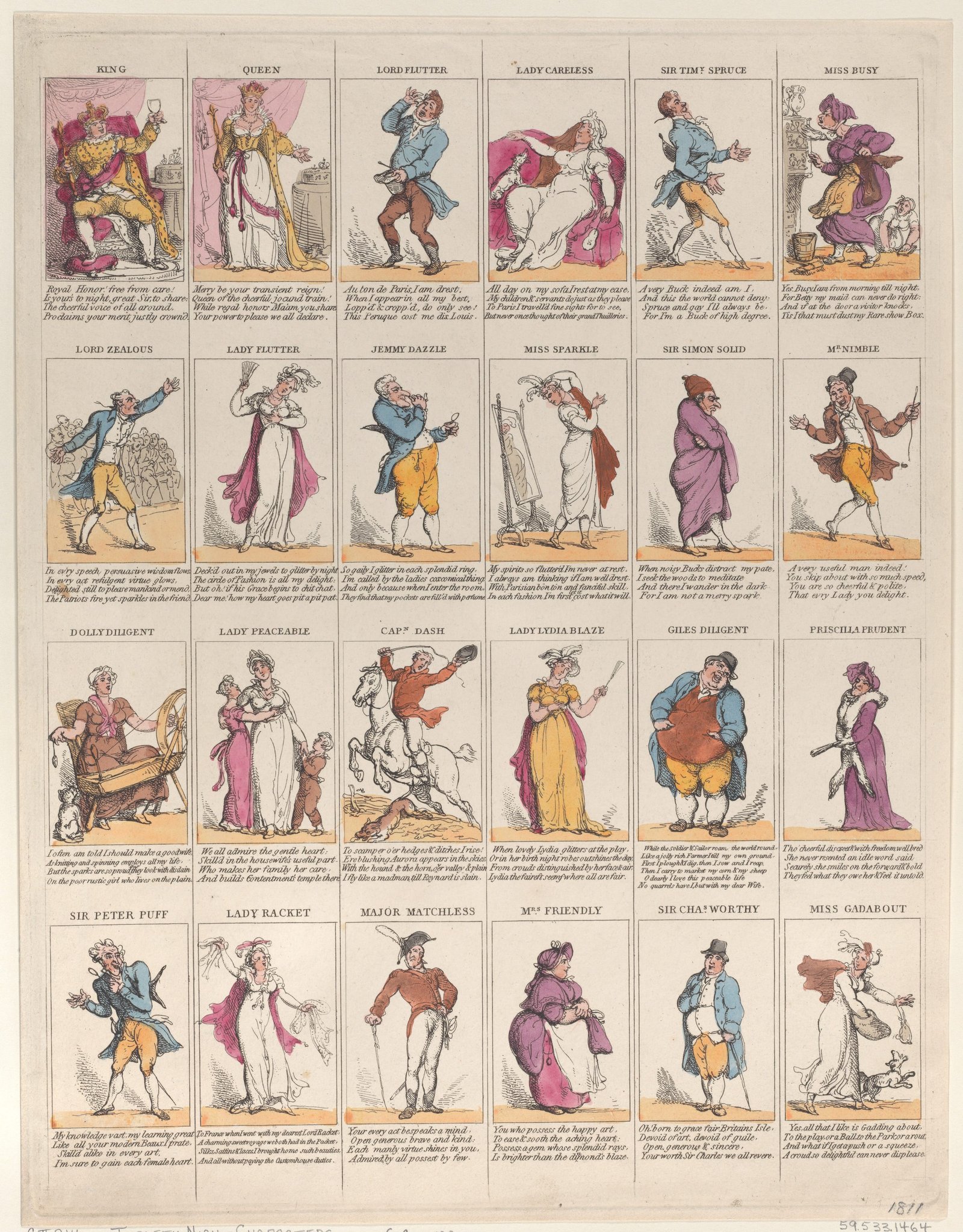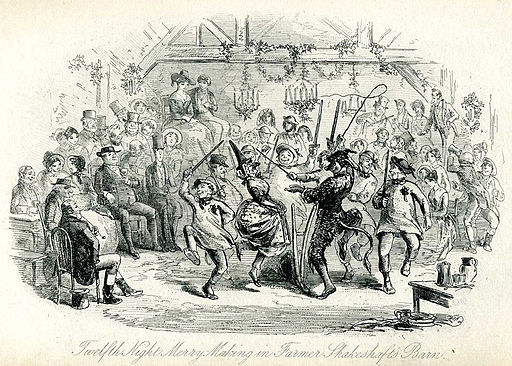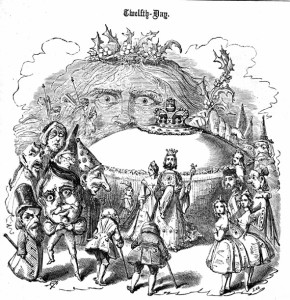Closing out the Holidays with Twelfth Night

The REAL twelve days of Christmas began on December 25 and continued to January 6!
The historic origins of Twelfth Night
The Twelfth Night celebrations, also known as the Feast of Fools, trace back to ancient pre-Christian festivals, including the Celtic festival of Samhain and the Roman festival of Saturnalia. A common theme of these festivals featured the inversion of social roles and sometimes a Lord of Misrule who would turn everything upside down. Kings become peasants and servants become masters. A night of chaos and frivolity provided a fitting foil for the Feast of the Epiphany that celebrated the visit of the magi to the Christ child.
Also called Old Christmas Day, Twelfth Night also reflects a mid-18th c shift in the Gregorian calendar. In 1752, eleven days were removed from the calendar. This meant that January 6 was actually the previous calendar’s Christmas day. Considering how upset people get with modern daylight savings time, it isn’t really surprising that people upset by the change would have continued to celebrate Old Christmas day, rather than the new. (This continued through the 19th c.)
Twelfth Night Revels
Epiphany or Twelfth Night (Jan 5) was the exciting climax of the month-long Christmastide season. The two weeks between Christmas and Twelfth Night in particular were a time to put away social norms. Visits, balls, and all sorts of parties would be in full swing during this period. Card parties, ice skating parties, evergreen cutting parties would be common, with many parlor games keeping spirits bright.
The world turned upside down aspect of Twelfth Night made the parties during this period unusual. Children were often included in the balls. Masquerade parties and balls were common, as were role playing games, like the use of Twelfth Night characters.
Twelfth Night Characters
Revels, masks and balls were the order of the day and night. Typically, each guest would randomly select a character to play by drawing a slip of paper from a hat or bag. Some hostesses would send characters around to her guests so that they could come already dressed as their character. Others might provide dress up items for their guests to don after characters had been chosen. Guests had to remain in character for the entire evening. If a guest broke out of character during the night, they would have to pay a forfeit later.
Since the world was upside down on Twelfth Night, servants were often included in the revelries. This could become particularly interesting when one became the king or queen for the evening.
Besides the King and Queen, a variety of characters, were often pulled from popular literature and plays. Common characters were Sir Gregory Goose, Sir Tumbelly Clumsy, Miss Fanny Fanciful and Mrs. Candour. Sets of pre-made characters could be purchased from stationers, or a family might copy them from books on games and merry-making.
Rachel Revel (1825) offered an extensive set of characters in her book as well as instructions that as each character is drawn the conductor of the game arrange them in order of their number and when all the guests have characters, they may each read lines to introduce their character in turn.
For example:

1. King: Fate decrees me your King: grave and gay, wise and fools, Must consent, for this night, to submit to my rules.
2. Queen: I’m your Queen: good my liege, your confessor, may shrive you; But for me, I’m resolved, if I can’t lead, I’ll drive you.
3. Lord Spendthrift: Blood, for money, Lord Spendthrift is ready to barter, If some rich maid will purchase a Knight of the garter.
4. Molly Mumper: Molly Mumper wants a husband: Baron, or Duke, she cares not which; If you’ll marry a beggar’s heiress, she’ll promise to make you rich.
5. Lucy Leerwell: “Tis so humdrum to live single, Lucy Leerwell would prefer, On some facetious youth, her hand and fortune to confer.
6. Joe Giber: Take Joe Giber, the king’s jester, he’s the fellow for your yoke, Tho’ marriage, it must be confess’d, by most wits is counted no joke.
7- Miss All-agog: Miss All-agog’s a candid girl, who hates monastic vows, And she will never take the veil if she can get a spouse.
8. Sam Sadboy: Sam Sadboy’s neither monk nor friar; he sees into your views:Marry him, you may cast off your veil, and the rest of your deeds when you choose.
9. Miss Romance: Miss Romance to accept for her partner proposes, One who’ll print in his press ev’ry work she composes…
Twelfth Night Feasting

Festivities as grand as Twelfth Night always include food. Certain foods become associated with, and even iconic of a celebration. Several were associated with Twelfth Night.
Mince Meat Pie
Though many dishes graced the tables for Twelfth Night revelry, two particular dishes were known for their connection to Twelfth Night. Most considered mince meat pies, also known as Christmas or Twelfth Night pies staples for a Christmas feast. Recipes varied by region, but usually included beef, poultry and other meats, suet, sugar, raisins or currants, spices, orange and lemon peel, eggs, apples and brandy.

Leftovers from the Christmas feast would be used to make pies for the twelve days until Epiphany. Eating minced pie every day of the twelve days of Christmas was said to bring twelve months of happiness in the new year. To strengthen the charm, the pies must be baked by the dozen and offered by friends.
Twelfth Night Cake
A special Twelfth Cake, would be the centerpiece of the party. The cakes were elaborate creations with sugar frosting, gilded paper trimmings, and sometimes delicate plaster of Paris or sugar paste figures.
In towns, confectioners would display these cakes in their shop windows, illuminated by small lamps so the displays could be admired during winter evenings. Recipes for Twelfth Cake do not appear in print until 1803, although either of these recipes might have been used prior to that to make it.
To Make a Rich Cake
Take four pounds of flour dried and sifted, seven pounds of currants washed and rubbed, six pounds of the best fresh butter, two pounds of Jordan almonds blanched, and beaten with orange flower water and sack till fine; then take four pounds of eggs, put half the whites away, three pounds of double-refined sugar beaten and sifted, a quarter of an ounce of mace, the same of cloves and cinnamon, three large nutmegs, all beaten fine, a little ginger, half a pint of sack, half a pint of right French brandy, sweet-meats to your liking, they must be orange, lemon, and citron; work your butter to a cream with your hands before any of your ingredients are in; then put in your sugar, and mix all well together; let your eggs be well beat and strained through a sieve, work in your almonds first, then put in your eggs, beat them together till they look white and thick; then put in your sack, brandy and spices, shake your flour in be degrees, and when your oven is ready, put in your currants and sweet-meats as you put it in your hoop: it will take four hours baking in a quick oven: you must keep it beating with your hand all the while you are mixing of it, and when your currants are well washed and cleaned, let them be kept before the fire, so that they may go warm into your cake. This quantity will bake best in two hoops.
~Hannah Glasse
To make icing for a Bride Cake.
Almond Iceing for the Bride Cake. Take the whites of six eggs, a pound and half of double refined sugar; beat a pound of jordan almonds, blanch them, and pound fine in a Iittle rose water; mix all together, and whisk it well for an hour or two; then lay over your cake, and put it in an oven.
Every woman her own housekeeper , John Perkins 1790
The end of the holiday season
Decorations, which were put up on Christmas eve, were to be taken down and burned by midnight on Twelfth Night or the household would face bad luck for the rest of the year. Some believed that for every branch that remained a goblin would appear. Others suggested that if the decorations did not come down on Twelfth Night they needed to be left up until Candlemas Day on February 2, or even Shrove Tuesday, 47 days before Easter Sunday, generally falling between the first week of February and the first week of March. If left up until Shrove Tuesday, the decorations must be burnt and pancakes cooked over the flames.
Into the Victorian Era and Beyond
Although Twelfth Night revelry could be peaceable and even family-friendly, it often became quite riotous as rowdy games and large quantities of highly alcoholic punch were the order of the evening. In the 1870′s, Queen Victoria struck the celebration of Twelfth Night from official calendars in fear the celebrations had become out of control.
New industrial working condition no longer permitted an extended holiday season, since the factories had to keep running. Thus beginning the demise of the extended holiday in favor of the much shorter ‘modern’ Christmas celebratory season.
References
Glasse, Hannah. The Art of Cookery Made Plain and Easy. (1784)
Hanes Cymru Twelfth Night January 5, 2016 https://martinjohnes.com/2016/01/05/twelfth-night/
Chuck Hudson https://historicinterpreter.wordpress.com/2015/01/05/happy-new-year-everyone/
London Every woman her own housekeeper John Perkins 1790
Christmas in the Regency Jo Beverley
‘Winter Evening Pastimes or The Merry Maker’s Companion’ Rachel Revel, 1825
https://www.tavistockhistory.co.uk/single-post/2017/08/01/a-brief-history-of-twelfth-night
If you enjoyed this post you might also enjoy:

You always have such depth to your research. Well done. Thanks for sharing. Happy New Year.